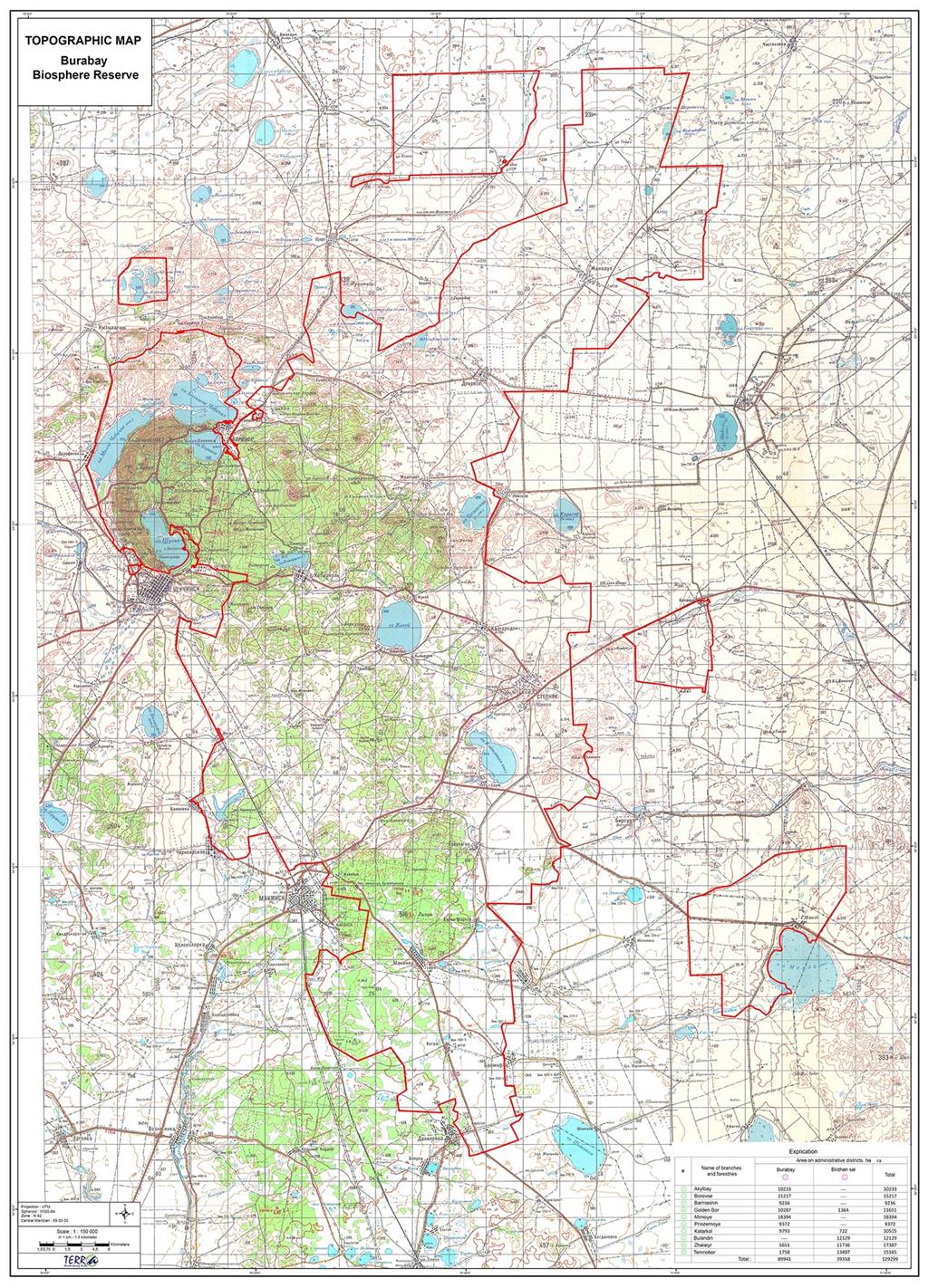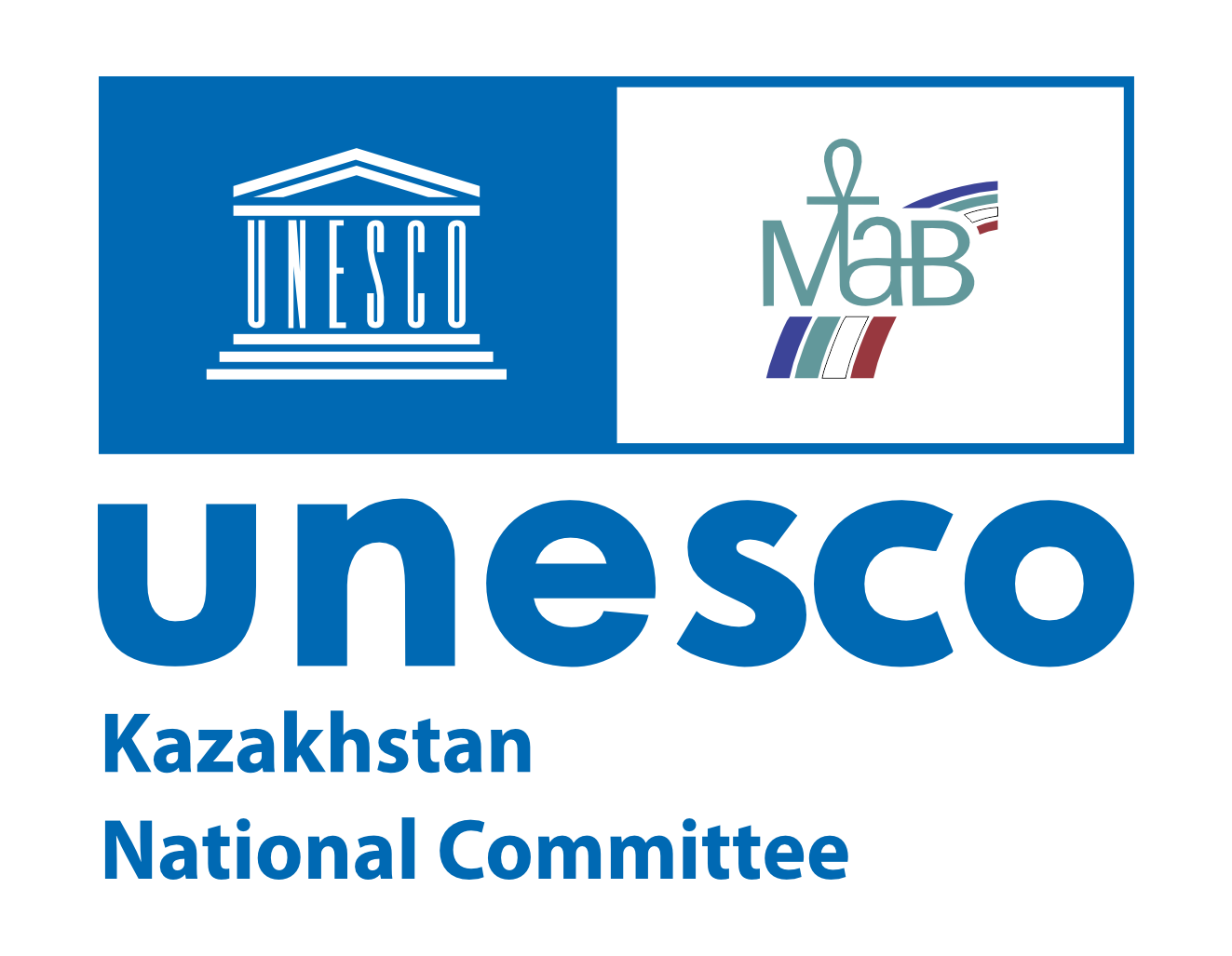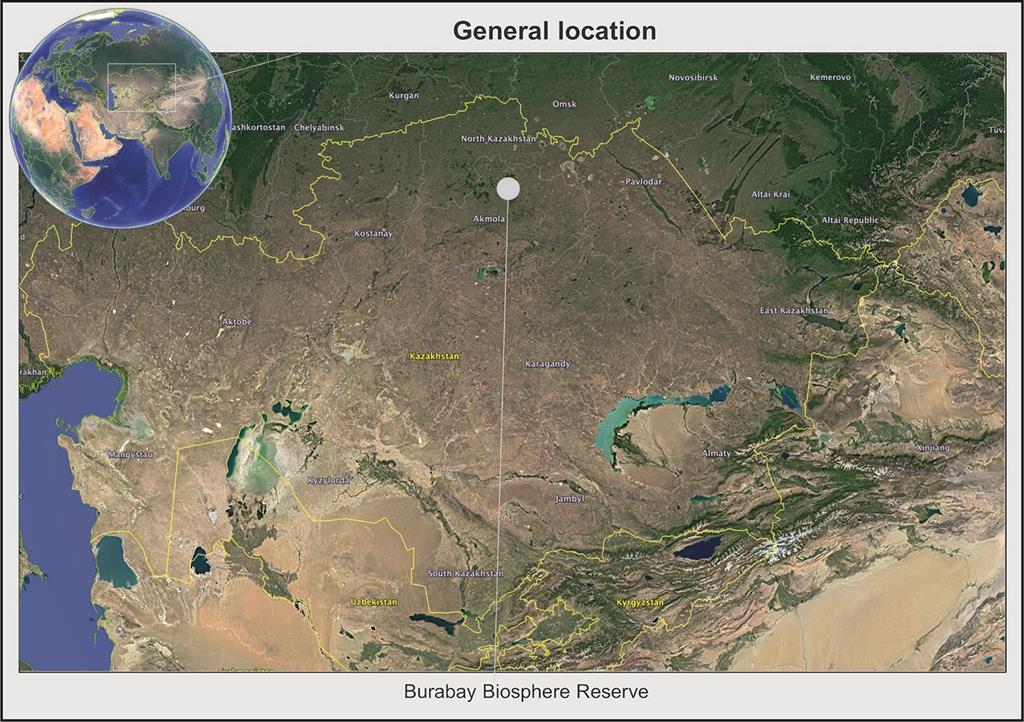
The Burabay Biosphere Reserve is located in the steppe-forest-steppe natural zone in the most elevated part of the northern outskirts of the Central Kazakhstan melkosopochnik at altitudes within 220-947 m above sea level. The highest levels are observed in the western and central part of the biosphere reserve, where the Kokshetau Mountains and the Shchuchinsky Hills are located, stretching north from the city of Shchuchinsk in the form of a semi-ring ridge to the village of Borovoe. In the low-mountain massif of Kokshetau in the area of the lakes of the Borovsky group, the highest absolute marks are observed: 947 m - Mount Sinyukha (Kokshe), 838 m - Mount Sedlovatka (Zheke Batyr).
The total area of the Burabay Biosphere Reserve is 129,299 hectares. The core area accounts for 14,052 ha, the buffer zone – 43,221. 3 ha, the transition area - 72,025. 7 ha. The core area of the biosphere reserve is a strictly protected zone of the protected regime of the state National Natural Park Burabay, which preserves the most valuable natural mountain ecosystems of the Kokshetu Upland. The buffer zone of the biosphere reserve according to Article 45 (paragraph 1) of the Law of the Republic of Kazakhstan "On Protected Areas" is the zone of ecological stabilization of the state national nature park Burabay. According to Article 45 (paragraph 1) of the Law of the Republic of Kazakhstan "On Protected Areas", two zones of the state National Natural Park Burabay are the transit area of the BR Burabay. 1) tourist and recreational activities; 2) limited economic activity. According to Article 45 (paragraphs 4, 5 and 6), as well as Articles 46-48 of this Law, as well as a specially designated protected area of the reserve, which covers a two-kilometer strip along the perimeter of the national park. All three zones are connected and complement each other. The core area is closed to visitors and represents reference areas of regional natural complexes, as well as an inviolable genetic reserve of wild species of flora and fauna, this area is a control one during long-term monitoring.
The buffer zone is also under a protective regime, but here limited economic activity is carried out taking into account the preservation and restoration of objects of the state nature reserve fund and according to the relevant permits of the state bodies under whose jurisdiction they are located. Tourist and recreational activities in this zone are carried out directly by the state national natural park or by individuals and legal entities if they have a license for tour operator activity. For individuals and legal entities, the obligation remains to bring the site into a state that ensures the safety of objects of the state nature reserve fund, and compliance with environmental protection requirements. Both zones perform the function of preserving natural complexes and partly the function of sustainable development.
In the transition area, the main types of traditional economic activities of land users that ensure the sustainable use of natural resources are allowed, but the types of nature use and economic activities that negatively affect ecological systems are prohibited or restricted. Restrictions on the economic activity of owners of land plots and land users in the protected zone of the state national natural park are established by decisions of local executive bodies of regions, cities of republican significance, the capital in accordance with this Law. This zone is used for the implementation of the vital activities of the local population, the development of the economy, culture and education and provides the function of sustainable development of the territory.
In general, the existing zoning provides for overcoming the conflict between socio-economic development and the protection of wild natural complexes and provides an opportunity for sustainable economic and cultural development.
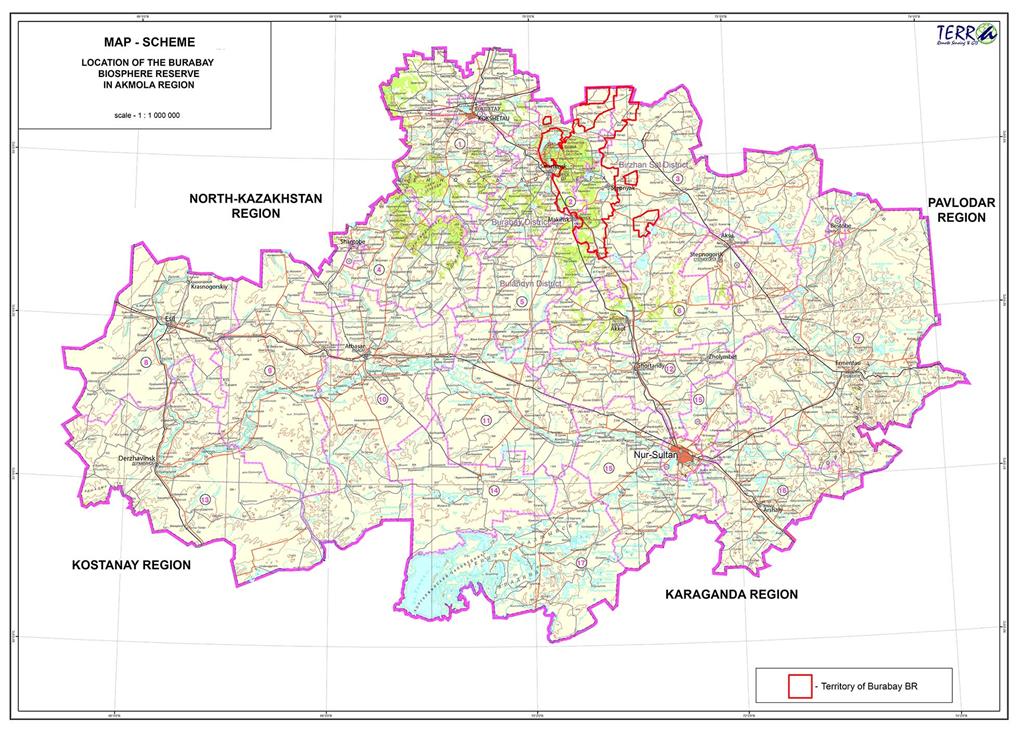
Currently, there is a Management Plan for the State National natural Park Burabay, which relates to the management of all functional zones of the biosphere reserve, which is also integrated with the management plans of nature users who carry out their activities in the transit area. All disputes between land users are resolved at meetings of the BR Coordination Council.
The management of the BR is carried out through the Coordination Council of the Burabay BR, established in 2021. Previously, the entire territory was managed through the Scientific and Technical Council of the Burabay National Natural Park. The Coordinating Council is a collegial public body and was created for the purpose of implementing the policy of effective management and sustainable use of BR resources, the introduction of alternative activities, resource-saving and resource-renewing technologies. The Coordination Council of the BR, which includes representatives of state agencies (the territorial Department of forestry and hunting), the State National Natural Park, local authorities, local non-governmental organizations and land users, is also necessary to ensure cooperation and overcome contradictions between all nature users.
The biosphere reserve is organized on the basis of the state National natural Park Burabay. In accordance with the Decree of the President of the Republic of Kazakhstan dated February 27, 1997 No. 3369 "On additional measures to strengthen the protection of the Borovsky mountain forest", the decree of the Government of the Republic of Kazakhstan dated May 06, 1997. No. 787 Borovskoye Forestry of the Economic Department of the President and the Government of the Republic of Kazakhstan was transformed into the State Institution "Natural Health Forest Complex "Burabay" of the Economic Department of the President and the Government of the Republic of Kazakhstan, on the basis of which, on the basis of the order of the President of the Republic of Kazakhstan dated July 16, 1999, No. 98, the State National Natural Park Burabay was created.
According to preliminary data, the total number of flora species for the territory of the Burabay BR reaches 840 species of higher plants, while the largest number of species is concentrated in forests. Of these, 91 plant species are rare or relict, need special protection, including 11 species found here that are listed in the Red Book of Plants of Kazakhstan (2014). 37 species of mosses, 11 species of lichens and 17 species of ferns were identified in the flora of the lower plants. Lichens are represented by 11 species and are divided into the following groups according to their proximity to the substrate: epigeic, epiphytic, epilitic. Three species of the genus Cladonia dominate – C. sylvatica, C. alpestris, C. rangiferina. Mosses are found in wet and moist habitats, the dominant species are Pleurozium schreberi, Dicranum scoparium, Hylocomium palustre, Climaceum dendroides, etc. The flora includes 81 relict species-representatives of the boreal flora of the northern taiga, which are located here on the southern border of their range.
The vegetation of the BR territory is represented by six main types: forest, shrub, steppe, meadow, marsh and salt marsh. Woodlands are an extrazonal phenomenon. A significant area is occupied by pine forests (Pinus sylvestris), as well as birch-pine and pine-birch (Betula pendula, B. pubescens).
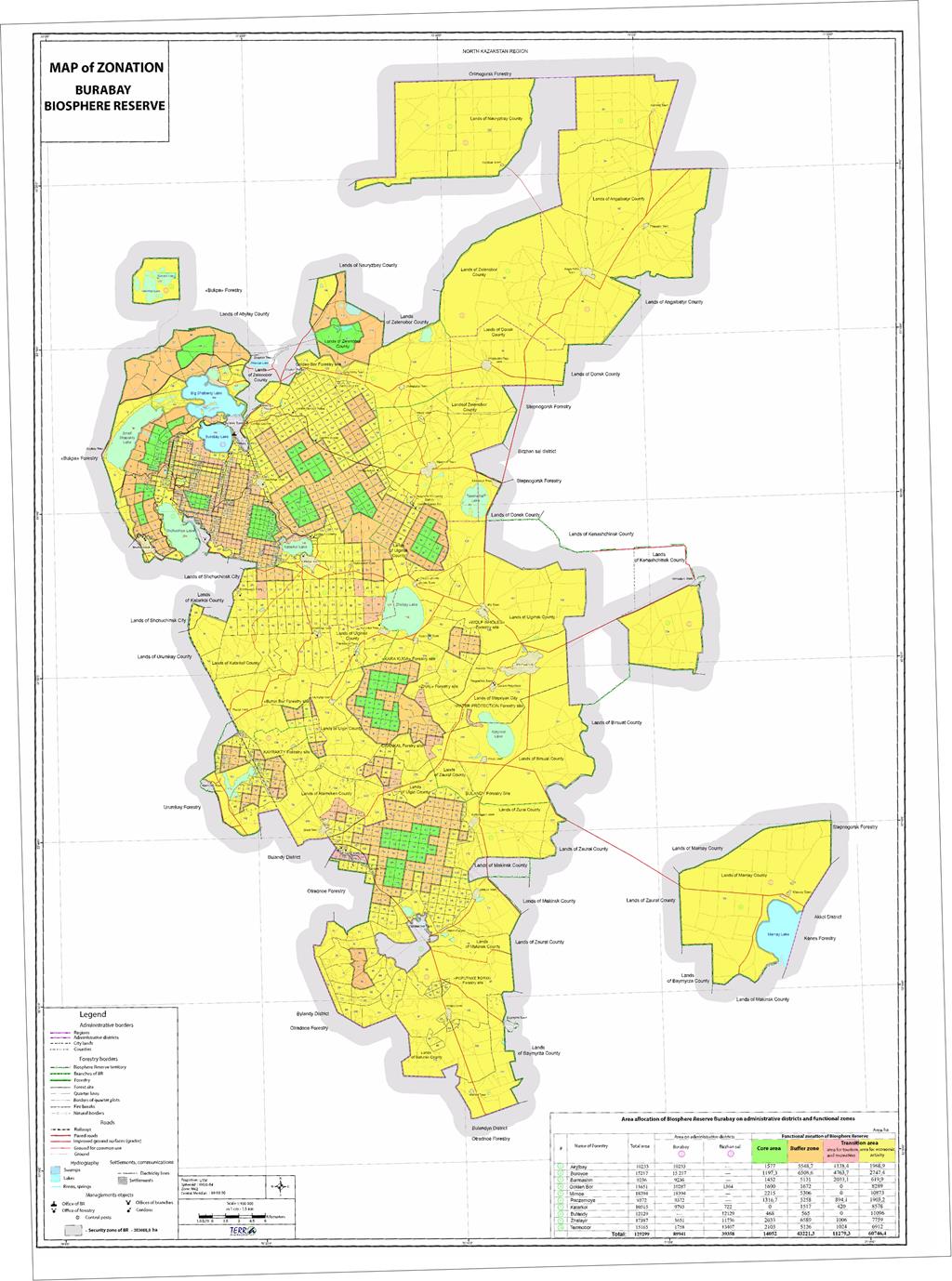
The fauna of vertebrates includes 277 species belonging to 25 orders, including 15 species and subspecies of fish, 1 species of amphibians, 5 species of reptiles, 209 species of birds and 47 species of mammals (about 36% of the total vertebrate fauna of Kazakhstan). Of these, 1 species of mammals and 18 species of birds are listed in the Red Book of Kazakhstan, 2 species of fish, 12 species of birds, 8 species of mammals are included in the IUCN Red List.
The territory of BR Burabay is administratively located within the Burabay district and Birzhan Sal district of Akmola region. Both districts are a grain-growing region with a great potential for agricultural development. In the Burabay district, there are 244 agricultural formations, including 43 LLP, 201 peasant farms, as well as 12 large and 60 medium-sized and small industrial enterprises, the number of people employed in them is 2152. There are about 320 agricultural enterprises operating in the Birzhan Sal district, the mining industry accounts for 65.2%, the manufacturing industry 32.1% and other sources – 2.7 %.
The Burabay BR consists of 10 cluster sites, the reserve also includes forest patches interspersed with lands of other categories within the transboundary zone. The entire territory of the reserve is divided into 10 forest areas: Akylbayskoye (10233 ha), Borovoye (151217 ha), Barmashin (9236 ha), Zolotobor (11651 ha), Mirnoye (18394 ha), Priozernoye (9372 ha), Katarkol (10515 ha), Bulandin (12129 ha), Zhalayyr (17387 ha), Temnobor (15165 ha). Forestry departments combine forest workshops, which include 5 forest detours. In turn, the forest bypass is the lowest link in the planning structure of the park, its area in accordance with the established standards is on average 1,230 hectares.
There is very good access to the Burabay biosphere Reserve. From the southeast to the northwest, a section of the Astana-Petropavlovsk expressway and the Almaty-Yekaterinburg railway passes through the territory of the reserve. The territory is crossed in different directions by asphalt roads connecting the cities of Makinsk, Stepnyak, Shchuchinsk, Stepnogorsk and smaller settlements located in the Birzhan Sal district, Burabay and neighboring districts. Communication by road is open all year round, except for short periods during the winter, when there are blizzards and especially severe frosts, the Borovoe Resort railway station is located 25 km from the village. Burabay (the central estate of the BR "Burabay"), Makinsk station is 5 km from the estate of the Bulandin forestry. In addition, in the regional center of the Akmola region, the city of Kokshetau, there is an airport capable of receiving international flights.
The territory of the Burabay biosphere Reserve demonstrates its contrasting zonal natural conditions, from steppe to mountain-forest ecosystems of the Kokshetu upland. There are plains, small mountain ranges, and beautiful lakes framed by the wonderful beauty of coniferous and deciduous forests. The buffer and transit zone of the reserve has excellent opportunities for the development of tourism, recreation and entertainment industry. The presence of rich natural resources, good natural and climatic conditions make the region promising in terms of the development of recreation and eco-tourism, first of all.
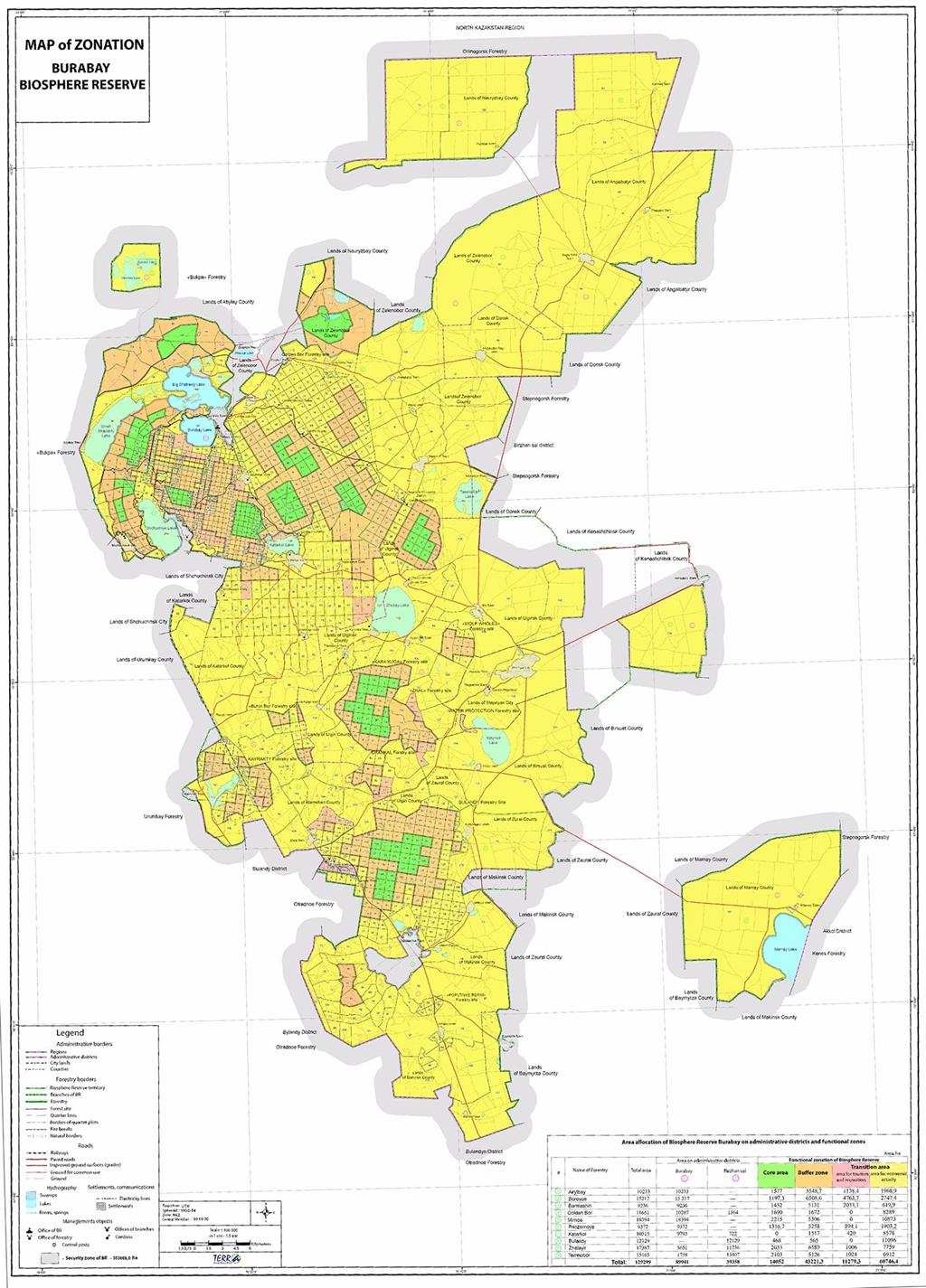
BR Burabay is part of the Shchuchinsk-Borovoe resort area. The region occupies an extremely convenient geographical position due to the proximity of industrial densely populated regions (including Russian ones) and the presence of trans-state air, railway and automobile highways. The Shchuchinsko-Borovskaya resort area is an ideal place for holding large prestigious and commercial events: congresses, forums, fairs, auctions, which allows you to more actively attract investment funds to the development. Currently, from 5 to 10 tourist infrastructure facilities are introduced annually in the kurotnaya zone. Among them are the 5* hotel "Rixos", the entertainment complex "Kazakhstan Lapland", the hotel "Park House", which has a multifunctional conference hall and rooms that meet high standards, the pantotherapy Center "Terrace Park", etc. To accommodate and serve tourists, there are hotels, hotels, tourist bases of various levels, more than 600 shops, public catering enterprises and organizations providing household services. A republican ski base has been built with a springboard complex and a biathlon platform, which will become the center of high-level international competitions with the attraction of numerous tourists as spectators. The construction of a modern golf club has been completed. Currently, there are 29 tourist routes in the Burabai Biosphere Reserve: 15 of them are trails, 14 are routes. Some of them are on foot (18), some are by bus (8), there are 1 equestrian, 1 bicycle and 1 water routes. The total length of all tourist routes is 503.5 km, while the total length of hiking routes is 246.5 km, bus routes – 226 km, cycling – 7 km, 1 horse – 9 km, water-15 km
In the Burabay Biosphere Reserve, ecological and educational activities are organized by employees of the Department of Science, Tourism, Information and Environmental monitoring, who annually plan and conduct various events:
- environmental training
- lectures
- environmental holidays and actions, including the annual March of parks
- meetings
- media appearances
- use of the reserve territory for educational purposes.
Environmental courses are held for students of secondary schools and colleges in the region. Lectures are given for vacationing tourists in sanatoriums, health resorts and hotels located in the resort area.
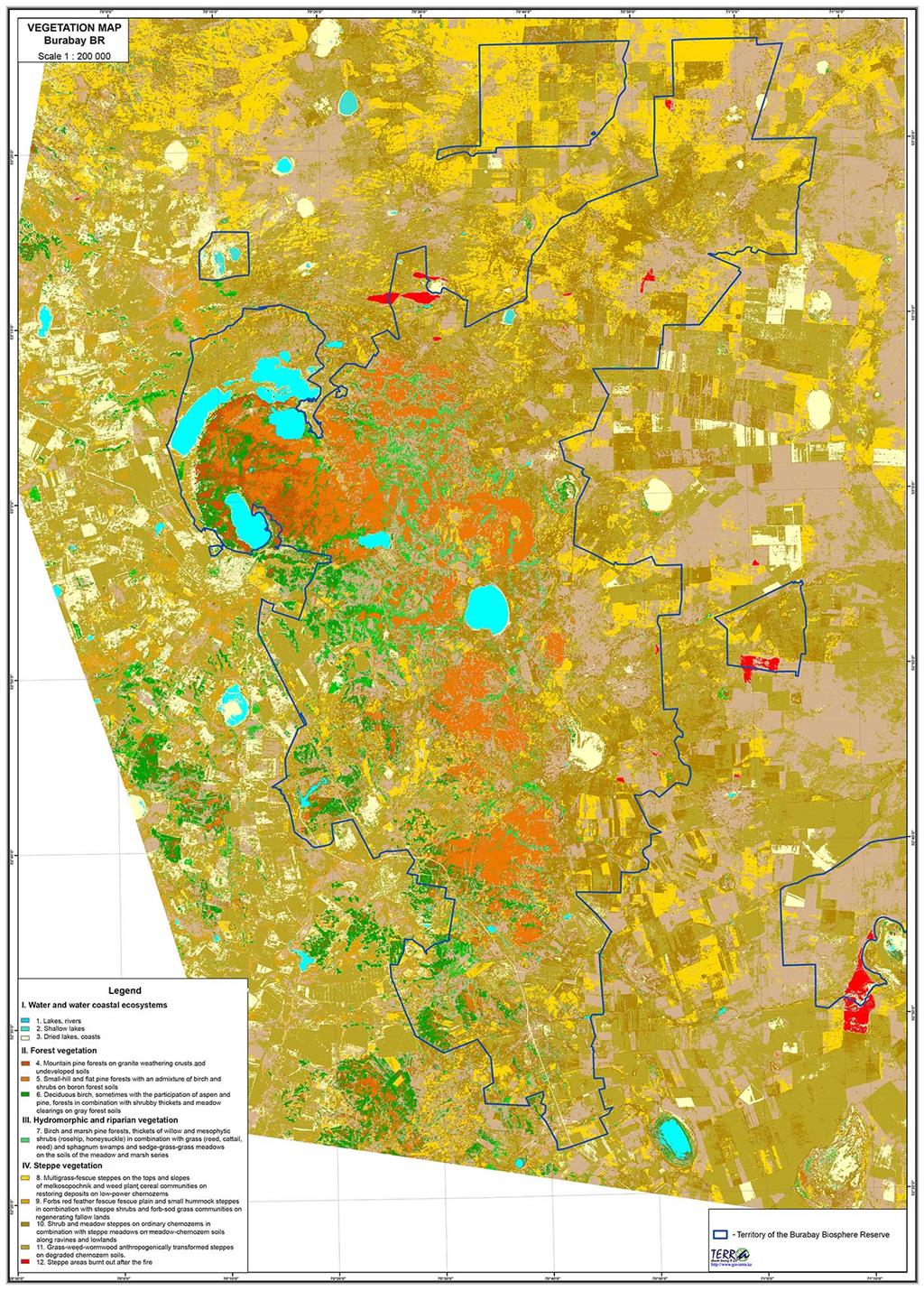
Every year, within the framework of the world environmental campaign "March of Parks", together with the public and educational institutions, the Burabay Biosphere Reserve conducts environmental actions, contests, talks, lectures, games, quizzes, film demonstrations in educational and other organizations of the region. Students of schools and colleges under the guidance of employees of the scientific department of the BR "Burabay" and teachers of educational institutions, as well as state inspectors, annually take an active part in the following environmental landings and environmental actions to improve the territory of educational institutions and the BR Burabay: "Live, spring!", "Bird housewarming", " Clean Lakes - clean shores!", "House for birds", "Plant your tree", " For a clean forest!", "Spring in the forest", " Breathe, twig!", "Primroses", " Let's green up our native school!", " Feed the birds!", " Take care of the spruce!", "Housewarming in the bird village", " Let's save nature together!", " Clean spring - living water!", "Take care of the Christmas tree-every needle", "Rest with benefits" and others.
The main scientific and technical support on the territory of the biosphere reserve is provided by all the personnel of the Burabay Biosphere Reserve, who have been trained in various courses within the framework of state programs for the development of the system of national protected areas. Training seminars were held on the preparation of a management plan, monitoring of biodiversity, compliance with safety and fire extinguishing regulations, as well as business trips to exchange experience in other biosphere reserves of Kazakhstan were organized.
The potential of the biosphere reserve is primarily associated with the development of ecological and recreational tourism, as well as with crop production and local industry. In the modern conditions of the development of the world economy, tourism is becoming one of the leading and dynamically developing industries. Tourism contributes to the development of key sectors of the economy (transport, communications, construction, agriculture, production of consumer goods) through tax revenues to the budget, increasing the number of jobs. One of the tasks facing the biosphere reserve is the development of tourist and recreational activities, the success and economic efficiency of which largely depends on the creation of a special infrastructure.
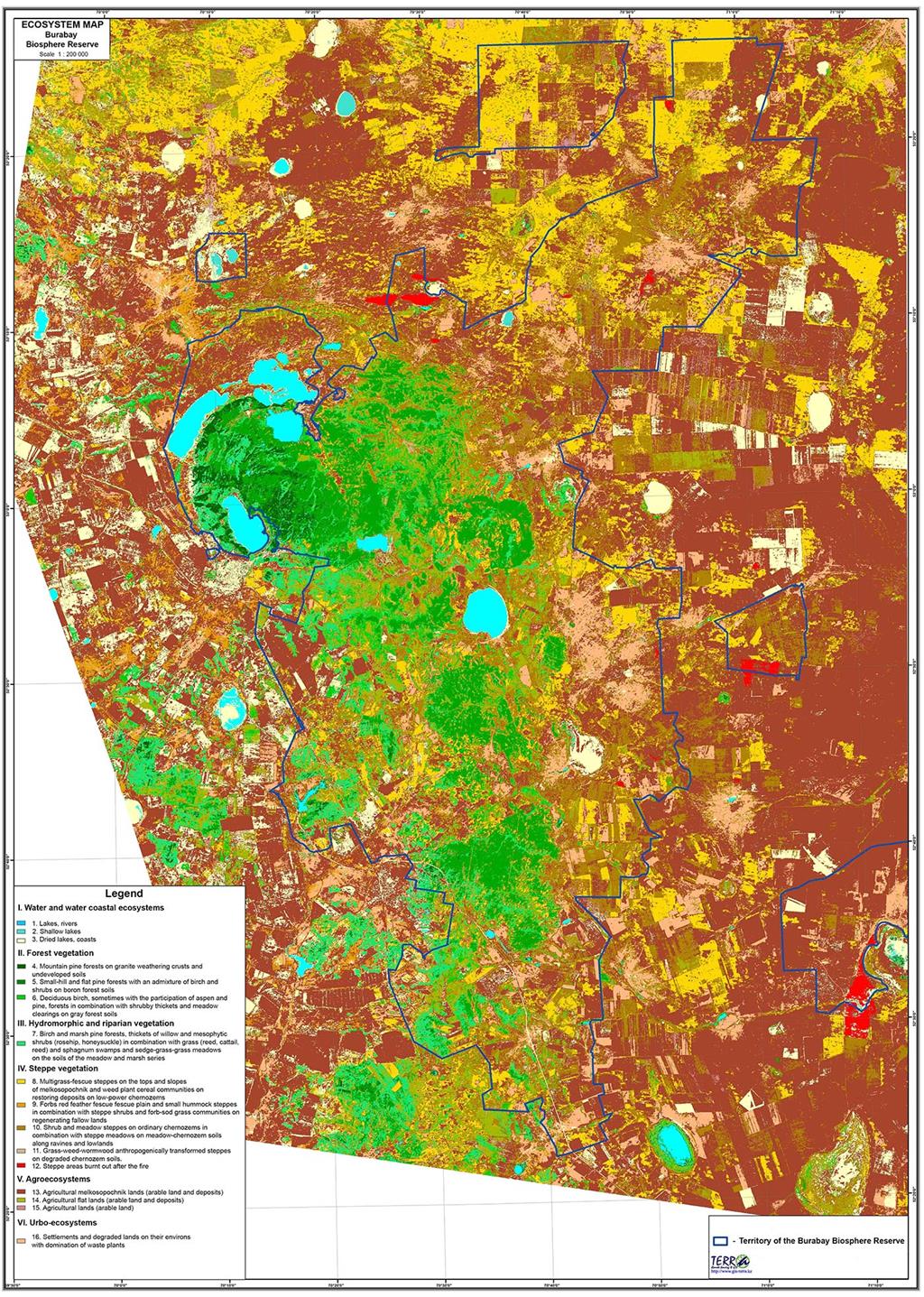
Every year, the number of visitors to the territory of the national park increases. So, in 2013, 526,620 people were registered, in 2014 - 615,644 people, in 2015 - 631,615 people, in 2016-644,541 people, in 2017 - 673,507 people. This number includes not only tourists and recreationists who visit the territory of the park for recreation, but also people who use other opportunities to communicate with nature provided by the biosphere reserve: picking mushrooms and berries, etc. This sets the task of developing a system of control over tourists present on the territory of the reserve, as well as the development of tourist services such as the provision of special scientific tours, winter recreation, the manufacture and sale of souvenirs, household products made of local materials (rugs and other products made of wool, stone and wood products, dried fruits, etc.), special photo and video products.
In total, for the provision of paid services to individuals and legal entities in the implementation of scientific, cultural, educational, tourist and recreational activities, the Burabay biosphere reserve received in 2013—39770,4 thousand KZT, 2014 - 63181 thousand KZT, 2015 - 29130,93 thousand KZT, in 2016 - 25156,6 thousand KZT, in 2017 - 24677,2 thousand KZT.
The Burabay Biosphere Reserve actively cooperates with many travel companies. So, in 2010-2017, agreements on joint activities were concluded with the following travel agencies: "Cruise" LLP, "Tourist" LLP, "Zhumbaktas - Sinegorye" LLP, "Express - REST" LLP, "Yassaui" LLP, "Voyage" LLP, "Nika Tour" LLP, "Globus" LLP, "Pearl of the Blue Mountains" LLP, "Mega Tour" LLP, "Burabay Damu" LLP, "SabDin tour" LLP," LOK Okzhetpes" JSC," KazMunayGas - Service" LLP," iceberg - 2012" LLP, JSC" Pavlodarturist", LLP" Amega tour", LLP"Vika - tour".
Currently, tourist services on the territory of the BR (settlements in the transition area) are dynamically developing. This is mainly due to the development of small and medium-sized businesses with the provision of additional services to tourists from the local population (organization of guest houses and small hotels and tourist bases, horse riding, etc.) with the sale of food from their own household and local souvenirs.
